
- 2023: The Biggest Legal Transfer of Wealth in History
- Why Next Year’s Recession Will Shock Most Americans
Someone had to call the chairman of the board, John Tuld, at 2:14 am.
It was the fall of 2008. Chairman Tuld had been expecting this call. He wasn’t a fool. He knew that mortgage delinquencies were soaring, even though the prices on mortgage-backed securities hadn’t been impacted – yet. He immediately flew in the company helicopter from the suburbs of Westchester to the roof of his bank on Wall Street, which was one of the largest and most important financial firms in the world.
Nothing in Tuld’s 44 years of banking had prepared him for what was waiting in his conference room.
A junior analyst, Peter Sullivan, sat at a long conference table, flanked by about a dozen of the bank’s top executives.
Tuld immediately got down to business.
“Mr. Sullivan, why don’t you tell me what you think is going on here, and please speak as you might to a young child or a golden retriever…”
“Yes… Well as you probably know, over the last 36-40 months, the firm has begun packaging new mortgage-backed securities products that combine several different tranches of rating classification in one tradable security. This has been very profitable, as I imagine you noticed…
“But the key factor is these are essentially just mortgages, so that has allowed us to push the leverage considerably beyond what you might be willing, or allowed to do in any other circumstance, thereby pushing the risk profile without raising any red flags.”
Tuld, fearing that he knew where this was heading, wanted a number. “And how far have we pushed that profile tonight, Mr. Sullivan?”
“We have pushed it to $1.215 trillion.”
As you might recognize, this is the script of the movie Margin Call. It is, by far, the best and most realistic dramatic rendering of the mortgage meltdown on Wall Street. It’s modeled after real-life events at Lehman Brothers.
We’d recommend watching the movie. Not just for entertainment. This is all about to happen again over the next 12 to 36 months. But this time, as you’ll see, the trigger will not be soaring default rates in mortgages. It will be soaring default rates in corporate bonds.
To jump ahead, what’s about to happen is a completely unprecedented collapse in investment grade bonds. Much like mortgage-backed securities in the 2000s, Wall Street has long regarded investment grade bonds as a completely safe asset. The previous peak default rate, in the 1970s, was only 1%. Thus, much like what happened before with real estate, huge amounts of leverage have been piled on top of these assets.
The result will be stunning losses across the financial sector – unlike anything ever seen before in the market for corporate debt.
Imagine that you’re Chairman Tuld. But instead of the fall of 2008, it’s the fall of 2023. And instead of dealing with collapsing real estate prices and soaring mortgage defaults, you’re dealing with collapsing equity values and soaring corporate bankruptcies.
“And Mr. Sullivan, what does your model say that means for us here?”
“Well… sir… if those assets were to decline in value by just 25 percent, and remain on our books… well… that loss would be greater than the current market capitalization of this company.”
“So what you’re telling me, Mr. Sullivan, is that the music appears to be about to stop and we are going to be holding the biggest bag of stinking sh*t ever assembled in the history of capitalism?”
“Well, sir, I’m not sure I’d put it that way, but let me clarify using your analogy: what this model shows is the music, so to speak, just slowing. If the music were to stop, as you put it, then this model would not be even close to that scenario. It would be considerably worse.”
An Economic Hurricane Is Coming
If there’s one thing that there’s plenty of in bond markets, it’s jargon.
Just ignore it.
There are really only two things you have to understand about the crisis that’s going to unfold next year.
First, the amount of money that American corporations have borrowed is unprecedented. As in, more debt than ever before in history.
And second: As with any other kind of credit market, the more people borrow, the lower the quality of the lending becomes. It’s inevitable.
You can see this clearly in the data…
The big three credit ratings agencies, Moody’s, Fitch and S&P Global, assign different grades to corporate bonds. These grades are based on key metrics like total debt and interest expense relative to profits.
The highest-rated debt classification is AAA, reserved for the most pristine balance sheets. Companies with high debt loads and interest expenses relative to profits fall on the opposite end of the spectrum, with grades of CCC or below.
And in between these two extremes, there’s a critical demarcation line between “investment grade” and “non-investment grade” bonds. The lowest rung on the ladder of investment grade bonds are “triple-B” (BBB)-rated bonds, as shown below:
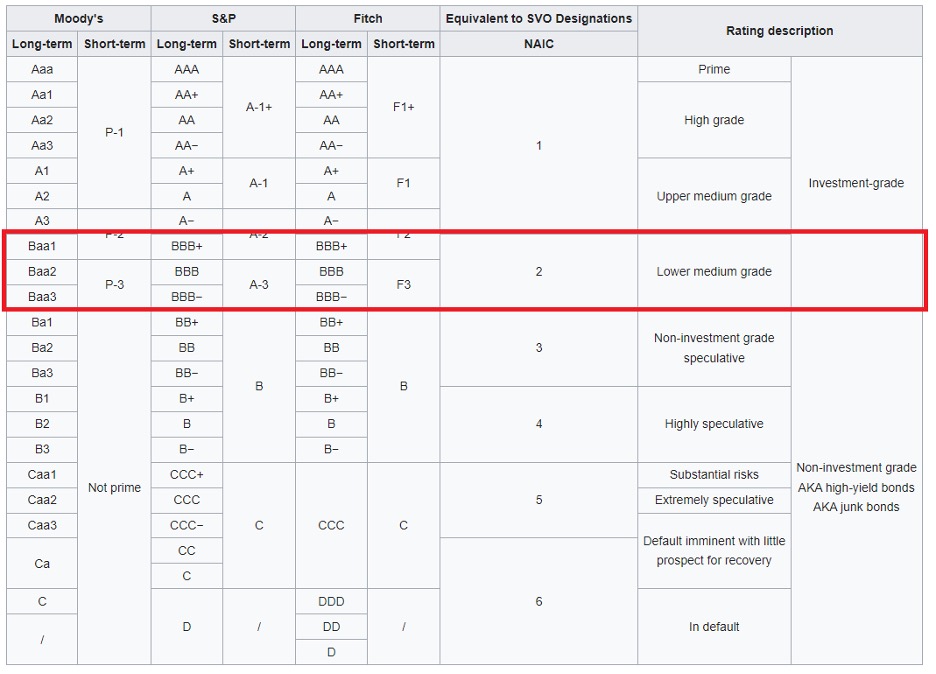
The triple-B class of bonds was the single biggest beneficiary of the corporate credit bubble of the last decade. From 2007 through 2021, the value of triple-B bonds in the U.S. surged from roughly $700 billion, to a record high of over $3 trillion today.
This explosion in issuance made triple-B debt the single biggest segment of the corporate bond market, which is now a record 58% of the investment grade universe:
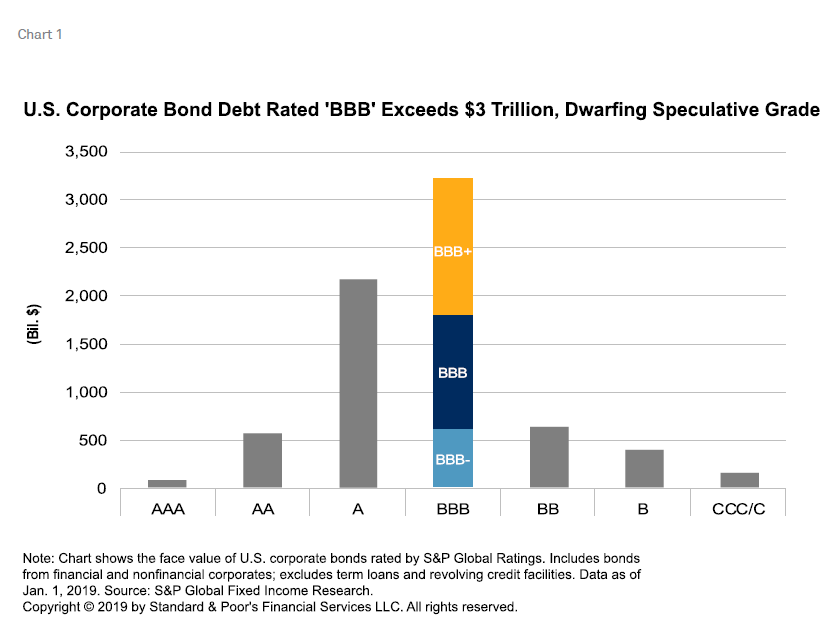
Meanwhile, the quality of investment grade deteriorated as ratings agencies became more lax in providing their stamp of approval over the last decade. The chart below shows how the leverage ratios of the investment grade debt universe roughly doubled from 1.5 times in 2007 to 3.0 times today:
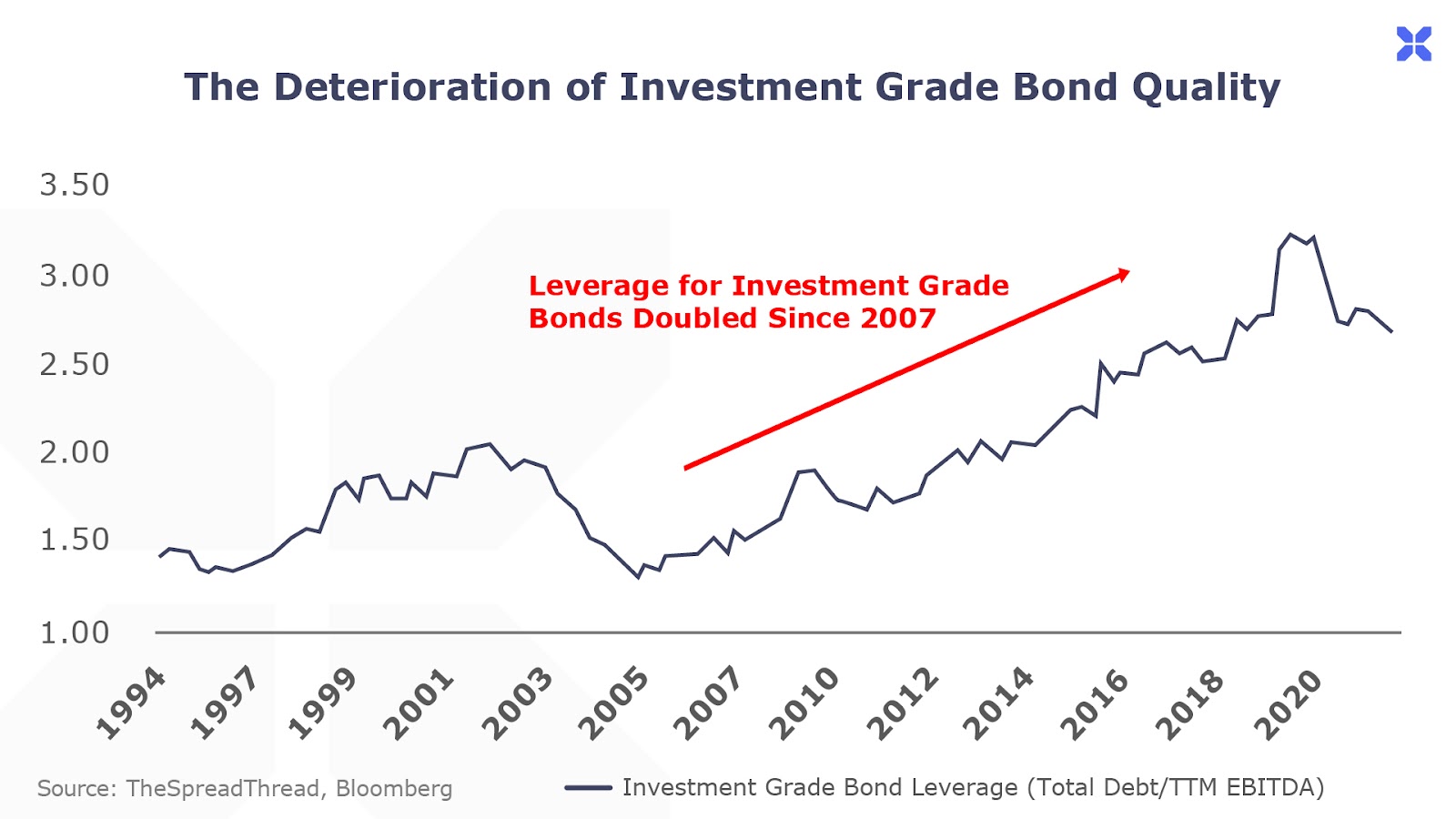
The explosive growth, and deteriorating quality, of the “investment grade” bond universe will play a major role in the coming corporate debt crisis. The reason is because a record volume of today’s investment grade bonds will soon get downgraded into non-investment status… and that’s a big problem for millions of American retirement accounts.
If you have a fixed income allocation in your 401(k) or IRA, chances are that you might own some of these bonds.
The Ticking Time Bomb in Americans’ Retirement Portfolios
By dropping rates to zero over the last decade, the Federal Reserve – and central banks around the world – pushed investors everywhere to reach for yield. Retirees were hit especially hard, as the Fed removed the ability to earn safe yields from the traditional retirement income vehicle – Treasuries.
So, countless retirees and other yield-starved investors found an alternative source of yield in corporate debt. That’s how the volume of corporate bonds held in mutual funds more than tripled since the Fed dropped rates to zero in 2009:
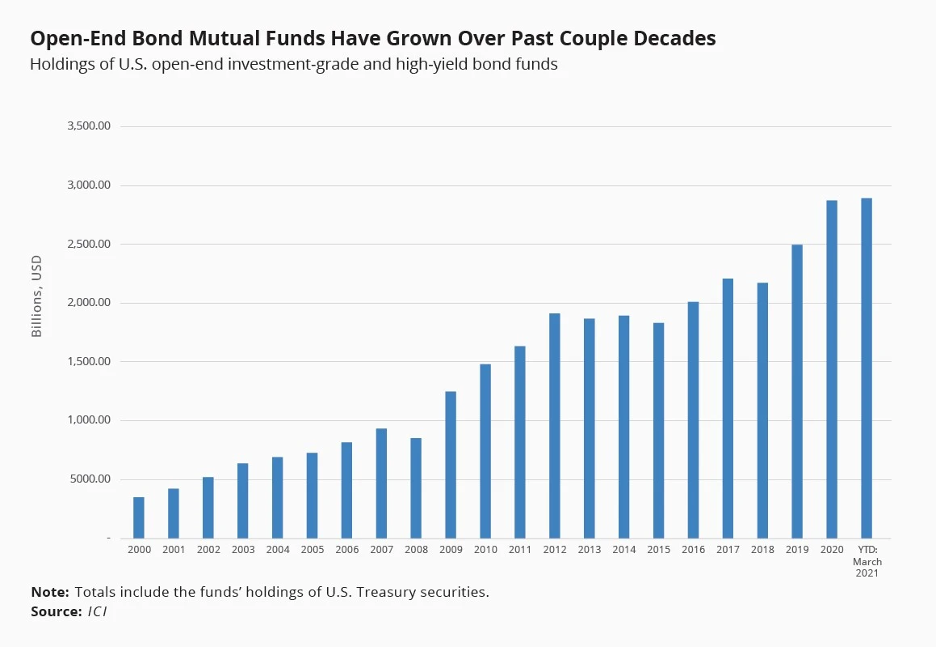
Likewise, the same reach for yield fueled an explosion in assets among corporate bond exchange traded funds (ETFs).
As regulators clamped down on reckless real estate lending in the wake of 2008, the credit created over the last decade migrated. Its new home was corporate bonds. And instead of going through the banks, this credit was funneled through alternative avenues, like mutual funds and ETFs.
The vast majority of mutual funds and ETFs that own corporate bonds are passively managed. That means there’s no human investment manager calling the shots. Instead, the buy and sell decisions are on autopilot, dictated by a series of rules. One of these rules says that if a bond loses its investment grade rating it must be sold. No debate, no discussion, no questions asked.
And bond ratings are dynamic. A bond rated “investment grade” today could easily get downgraded to “non-investment grade” tomorrow.
What could trigger such a downgrade? A decline in earnings, as a result of the recession, is one trigger. Another trigger is rising interest rates. In each case, the debt burden and interest expense relative to earnings deteriorates, exceeding the threshold for an investment grade rating.
A one-two punch of a sharp recession, caused by higher interest rates, would be the ultimate disaster scenario. And that’s precisely the scenario we see coming…
Given the massive growth in investment grade bonds sitting at the lowest rung of the ratings ladder, this would trigger an avalanche of downgrades into non-investment grade status.
And that means one thing – fire sales. Billions of dollars in sell orders coming from every passively managed mutual fund and ETF that owns investment grade corporate bonds.
Now, a fire sale in the highly-liquid stock market is one thing. But it’s a whole different story in the corporate bond market, where the average corporate bond trades about once a month.
The problem is, the mutual funds and ETFs holding these illiquid bonds create the illusion of liquidity. That’s because these mutual funds and ETFs are set up to allow for unlimited volumes of daily trading by individual investors. But the underlying instruments in these funds – corporate bonds – do not have sufficient liquidity to process large sell orders. This liquidity mismatch is a ticking time bomb waiting to go off if investors ever lose faith in their bond holdings and rush for the exits. Or, if a rash of downgrades forces the fund to dump bonds due to ratings downgrades.
Bank of England Governor Mark Carney once explained this fatal flaw…
“These funds are built on a lie, which is that you can have daily liquidity, and that for assets that fundamentally aren’t liquid.”
We had a preview of what the coming fire sale in corporate bonds will look like back in March 2020. The high-grade corporate bond exchange traded fund (ETF) collapsed by 22% in nine trading days:

The situation became so dire that for the first time ever, the Fed stepped in to buy corporate bonds. But this merely inflated the bubble further. After the Fed’s intervention, U.S. corporations sold a record $300 billion in debt in April 2020.
With inflation running out of control, this kind of intervention is now off the table. The coming fire sale will make March 2020 look like a picnic. The smart money knows what’s coming, and that’s why they’re selling first and asking questions later.
Where to Be When the Lights Go Out
Last Monday, more than $3 billion exited the largest investment grade corporate bond ETF (LQD). This was the single biggest one-day sale since the fund was launched in 2002, representing nearly 10% of the $36 billion in assets:
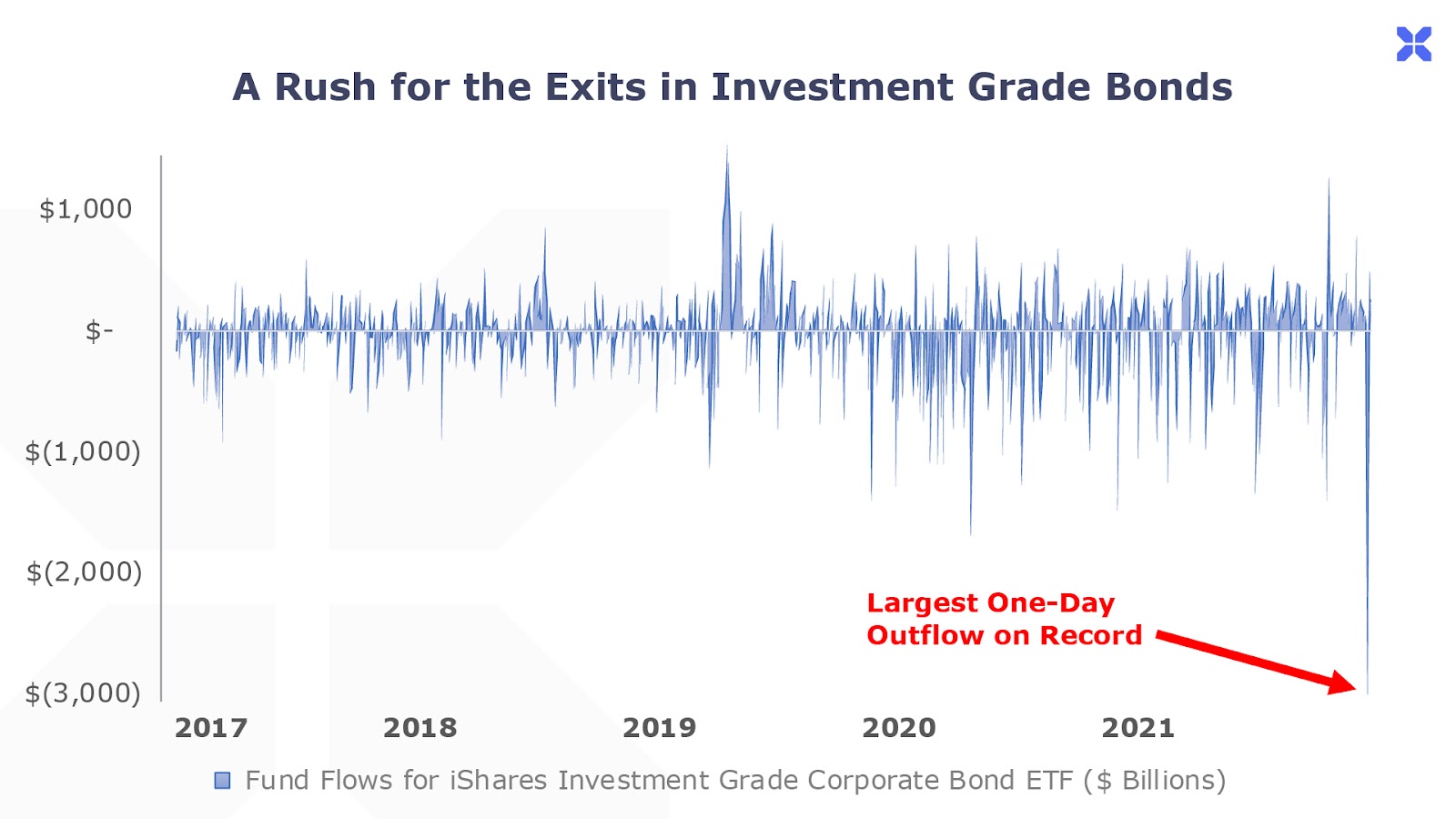
This is what the beginning of a fire sale looks like. And it’s right on cue with historic precedent. Over the last three decades, any time corporate debt reached 40 – 45% of GDP, a default cycle was triggered. Today, corporate debt to GDP is at an alarming 50% of GDP, ensuring one of the largest default cycles ever lies just ahead:

There will be a lot of carnage when the corporate debt bubble unwinds. And as with any crisis, it will also unleash incredible opportunities.
The same kind of opportunity that struck during the 2008 Financial Crisis, when high-quality stocks were crushed along with everything else. When today’s corporate debt bubble unravels, waves of forced selling will punish bond prices across the board.
Of course, just because a bond loses its investment grade rating, doesn’t mean that it won’t get repaid. Even during bankruptcy, the average corporate bond gets repaid to the tune of approximately 40 cents on the dollar. In the world of debt investing, “there are no bad assets, just bad prices,” to quote legendary bond investor Howard Marks.
During the coming corporate bond fire sale, prices will plunge to levels far below any reasonable estimate of fair value. For those who can separate the wheat from the chaff, fortunes will be made.
That’s why Porter & Co. will soon be launching a distressed debt publication. Stay tuned for more exciting details on this new product, and how we’re planning to help you capitalize on a once-in-a-lifetime debt investing opportunity.
This content is only available for paid members.
If you are interested in joining Porter & Co. either click the button below now or call our Customer Care team at 888-610-8895.